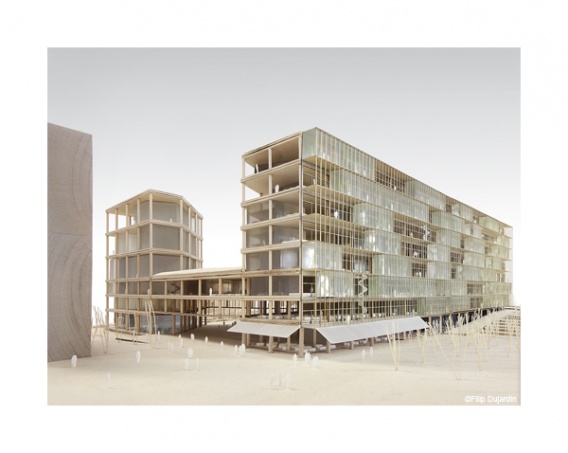
Architects appointed for new VRT building
Today, 7 January 2016, VRT appointed a consortium led by Robbrecht & Daem Architects and Dierendonckblancke Architects to design its new headquarters on Boulevard Reyers in Schaerbeek.
The appointment follows an architectural competition, launched by the Flemish Chief Architect, which drew entries from 66 teams of national and international designers. Five teams were shortlisted, including the winner.
Robbrecht & Daem Architects are known for major projects such as the Concertgebouw in Bruges, the Stadshal in Ghent, Rubens Square in Knokke and the renovation of Cinematek Brussels.
Projects designed by Dierendonckblancke Architects include the cultural centres in Avelgem and Beselare.
The winning team also consists of VK Group (stability, building services and acoustic consultancy), Arup UK (engineering and acoustic consultancy), Bureau Bas Smets (landscaping), Muller Van Severen (furniture) and Grontmij (cost management).
Work should begin in 2018. VRT’s staff and studios will move into the new building in late 2021. The building will also be used as a cultural and community centre.
As part of VRT’s Reyers 2020 Plan (http://www.canvas.be/reyers-2020), starting on 10 January the television channel Canvas will broadcast a series of five programmes about the five teams that put forward plans for Flemish public television company’s new building.
The new VRT headquarters will be the first concrete achievement of the mediapark.brussels project. This aims to create a lively new creative district on the Reyers site, for which the planning agency F. Leclercq is currently developing a master plan.
More information:
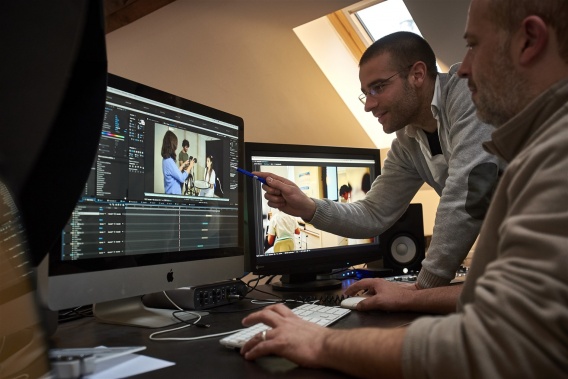
€4.5 million from the Region for the audiovisual industry
The government of the Brussels-Capital Region gave the go-ahead today for the creation of two funds worth a total of €4.5 million intended to support the audiovisual industry.
The audiovisual sector is an important component of the cultural and creative industry throughout the Brussels Region. The government is committed to promoting this promising sector, which features in the priority actions of the 2025 Strategy. ‘The Minister for the Economy and Employment, Didier Gosuin, and I have expressed the determination to capitalise on the economic potential of the audiovisual sector, which generates nearly 8,000 direct jobs and 7,000 jobs in the related field of communication – a total of 15,000 jobs,’ explained Minister-President Rudi Vervoort.
Umbrella brand: screen.brussels
To improve efficiency, it was vital to make the range of audiovisual services on offer in Brussels clearer to all stakeholders, in Brussels, Belgium and internationally. The government has therefore decided to develop an umbrella brand, screen.brussels, which will be divided into four components:
- screen.brussels film commission (currently Brussels Film Office);
- screen.brussels cluster (currently the sectoral cluster housed at impulse.brussels, bringing together more than 120 members);
- screen.brussels fund (a new Brussels co-production fund which replaces Bruxellimage-Wallimage);
- screen.brussels business (the SRIB-GIMB’s new dedicated funding facility).
As the first two of these initiatives had already demonstrated their usefulness, the Region wanted to develop the mechanism further by creating a dedicated funding facility and introducing a co-production fund.
A new fund for co-productions
Specifically, in consultation with the Walloon partner, the mixed fund Wallimage-Bruxellimage will be discontinued as of 1 January 2016 in favour of a co-production fund that is 100% from Brussels, worth €3 million, known as the screen.brussels fund. The idea is to gain full control of this highly effective form of leverage, and adapt it in the interests of Brussels and of the audiovisual industry based there. It will be managed by a separate structure overseen by the Minister-President, who has earmarked an additional budget of €500,000 to cover its operating and promotional expenses.
This new fund will make it possible to ensure that part of the audiovisual expenditure generated by the federal tax shelter scheme takes place in the Brussels-Capital Region. By increasing the competitiveness of the audiovisual sector in Brussels, the fund will help maintain and develop employment in the Brussels-Capital Region. Part of the allocated budget is intended to respond to developments in the way content is created, distributed and consumed for all types of screens. Through this initiative, the Region will play its pivotal role as a metropolis, promoting opportunities for collaboration with economic instruments used by the other two regions and with the cultural funds of the two linguistic communities.
A new funding facility for companies
In parallel with the creation of the screen.brussels fund, the Brussels government has decided to increase the resources for investment in companies in the sector. To this end, the SRIB-GIMB will be granted an additional budget of €1 million in 2016 under the name ‘screen.brussels business’.
‘By creating a specific line for companies in the audiovisual sector, the Region has followed the other two Regions in adopting an instrument that complements the fund for investment in content production. This facility will complement the SRIB-GIMB’s investments in companies in the sector. The goal is to create more possibilities for also investing in companies operating in emerging niches in the Brussels Region, such as gaming and virtual reality,’ explained Didier Gosuin.
This budget relates to contributions in loan or capital form in favour of Brussels SMEs operating in the audiovisual sector (i.e. companies active in areas such as audio, video and IT and their subcontractors, as well as suppliers of goods and services in the sector).
‘The goal of these new tools is to increase the resources used and raise the visibility of government action in favour of this industry. We are also striving to avoid any duplication or overlapping of competences and to take account of the statutes of the SRIB-GIMB,’ concluded the Minister-President.
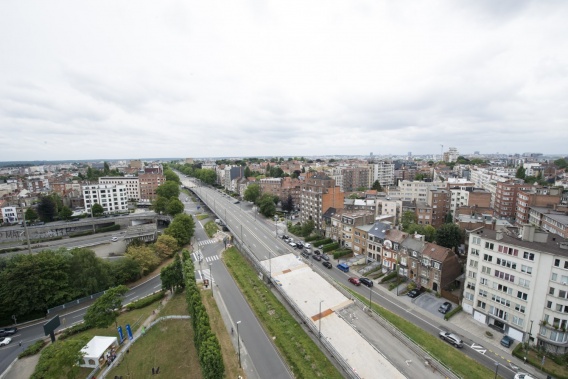
The Reyers district says goodbye to the viaduct
Several hundred people attended the local community celebrations organised by the Brussels-Capital Region on Sunday afternoon to say goodbye to the Reyers viaduct, the demolition of which should begin this summer.
The main attraction of this event for local residents was the chance to go on ‘Sky Watch’, a pod suspended by crane 60 metres above the ground for a superb view of the district and Brussels as a whole.
The decision to demolish the viaduct was taken last year by the Brussels regional government, because of the cost of renovating it. Built between 1969 and 1972, it will be replaced by a more user-friendly urban boulevard.
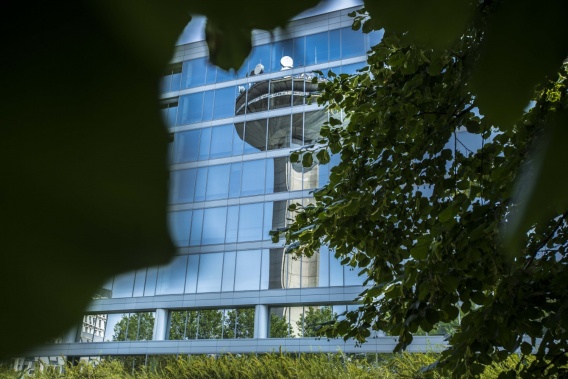
The ambitions for mediapark.brussels
The ambitions of the mediapark.brussels project and the major developments in the Reyers/Meiser district were presented today by the Minister-President of the Brussels-Capital Region, the Mayor of Schaerbeek, the CEOs of RTBF and VRT and the French architect and urban planner François Leclercq. The latter revealed the main concepts of the provisional master plan which he is responsible for devising for the reconfiguration of the RTBF-VRT site on Boulevard Reyers in Schaerbeek, which will become the heart of a new creative district that is open, diverse and vibrant.
This massive urban operation will create a new centre for the development of the Brussels region, in order to restore the quality of life at the heart of these areas, whose development has been seriously affected by the dense road infrastructure and by various economic activities that have developed on huge inward-looking sites. The new developments will incorporate housing, shops, services and leisure provision, but also will strengthen the economic fabric, among other means through the emergence of an innovative ecosystem centred on the media and the creative industries. This in relation with the future “Media cluster” funded by Europe and the Region within the framework of the launch of the operational ERDF program 2014-2020 of the European Regional Development Fund (ERDF).
The ambition of this project, dubbed ‘mediapark.brussels’, is to develop around the future new headquarters of RTBF and VRT an urban park of 8 hectares that will form the heart of a new Brussels district of exceptional quality – creative, diverse and vibrant. This open district, which will be a great place to live, work and relax, will be forward-looking and innovative in character by virtue both of its urban and architectural design and of its business activity, characterised by the proximity of numerous companies in the media and creative sectors employing some 5,000 workers.
The unifying and inspiring mediapark.brussels project, in relation with the Media cluster, will add value for Brussels and its people. In addition to the two new headquarters for RTBF and VRT, it features: the construction, ultimately, of some 3,000 new dwellings occupied by around 6,000 new inhabitants; local facilities and services (a nursery, a school, shops etc.) to meet the needs of local people; sites for innovative new businesses that will create jobs, colleges and public facilities linked with the media sector; an urban park used as a venue for events but also for walking and recreation; measures to reduce the impact of road traffic.
Situated at the confluence point between two stories (that of the Reyers/Meiser district and that of Belgian public broadcasting) and in a strategic location (between the European Quarter, Brussels Airport and Brussels’ university campuses), mediapark.brussels will become an attractive new centre whose influence will extend beyond the confines of Brussels. It will also reconnect the neighbouring districts, because it will be organised around a huge urban park that will replace the enclosed RTBF and VRT site, and through-roads linked up to the surrounding network.
Briefings, especially for local residents, will be scheduled shortly.
To follow the latest news on mediapark.brussels: https://twitter.com/mediaparkbru and www.facebook.com/mediapark.brussels
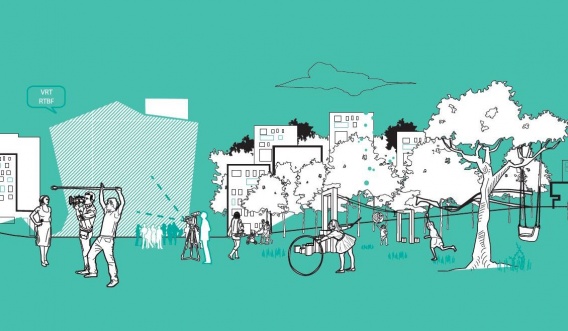
Reyers
Appointment of an international team to design the heart of the Media Cluster
An international team led by the architecture and urban planning firm François Leclercq has been selected to design a new metropolitan district and the heart of the Media Cluster.
The Brussels Region, the municipality of Schaerbeek and the two public broadcasting corporations have appointed a team of urban planners to design the diverse and vibrant new district around the new VRT and RTBF headquarters. The project will be developed on 19.6 hectares of land belonging to RTBF and VRT.
The winning team has 24 months to design this metropolitan urban project based on the construction of a Media Cluster, housing and local facilities and the development of a major regional park. It will also be responsible for supporting the implementation of the project.
The urban project is intended to address two sets of objectives:
- regional and municipal objectives relating to the development of the media as an economic sector by establishing a specific cluster, to the construction of housing and to the creation of quality public spaces;
- the objectives of VRT and RTBF concerning the restructuring of their buildings and their wish to be part of a dynamic district by the end of 2019.
An international consultation
The appointment has been made following an international consultation launched by the Urban Development Agency (ADT-ATO), acting in the name and on behalf of the Brussels-Capital Region, the municipality of Schaerbeek, RTBF and VRT.
Fourteen international teams responded to the call for applications. Four teams were selected to submit tenders on 31 March 2014. The teams’ proposals were submitted to an advisory committee comprising representatives of the project ownership, the chief architect of Brussels, the Flemish chief architect and external experts.
From Barcelona to Brussels
The selected multidisciplinary team consists of:
- Agence François Leclercq, which has a reputation for the development of major sites such as Paris Nord-Est, Euroméditerranée in Marseilles and its Bois Habité project in Lille;
- the architectural firm BOB 361, which among other projects designed the student centre in Antwerp and 59 passive social housing units in Forest;
- the Barcelona-based landscape agency Espinas i Tarraso, which was responsible for the redevelopment of the Barceloneta waterfront in Barcelona;
- the Spanish media planning agency NATEX, expert advisor to the Barcelona media cluster 22@BCN;
- the Belgian planning agency BUUR, which drew up the master plan and definition study for the RTBF/VRT site and will be responsible for the master plan’s impact study;
- and the consultancies CITEC engineering (mobility), Alphaville (urban planning), Transsolar (sustainable development) and Mageo Morel Associates (infrastructure).
Media cluster
First work proposals
The Brussels government wishes to develop and structure the media sector as part of the master plan for Key Area 12. It has instructed the ADT-ATO to build and run a Media Cluster on the Reyers site.
Recently, the ADT-ATO organised an information and consultation meeting attended by public and semi-public regional bodies with an interest in the development of the media sector in Brussels.
The Office of the Minister-President of the Brussels-Capital Region and the ADT-ATO shared their work proposals in order to rapidly initiate a launch process for the Media Cluster. They also gave a presentation on the progress of the Reyers urban project, a key element of the future Cluster.
The meeting gave an opportunity to share information on the various projects and schemes planned by the regional bodies to support the media sector. Various initiatives that could be undertaken in collaboration were discussed, including the diagnosis of business needs, the forecasting of storage capacity on the new site and coordination of public communications.
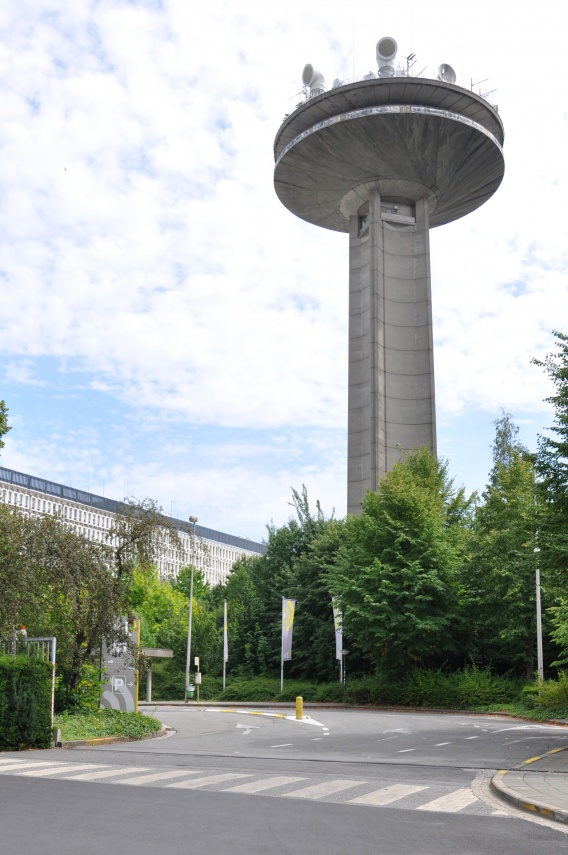
Reyers
A new district and a Media Cluster with RTBF and VRT
Today (22 April), the Brussels-Capital Region announced the creation of a new district on the Reyers site. This decision follows the wish expressed by VRT and RTBF to restructure their facilities there.
In order to redefine a site development strategy in this new context, the Urban Development Agency (ADT-ATO) organised a workshop bringing together the regional administration, the municipality of Schaerbeek, RTBF, VRT, the chief architect of Brussels Olivier Bastin, the Flemish chief architect Peter Swinnen and the author of the master plan, BUUR.
The purpose of the project is to:
- create a new area of the city that will be diverse and vibrant, based around an urban park;
- to develop a Media Cluster around the new VRT and RTBF headquarters, positioned at the centre of the site.
It thus simultaneously meets VRT’s and RTBF’s restructuring objectives and the regional objectives relating to the development of the media and broadcasting as an economic sector, to the construction of housing and to the creation of quality public spaces.
This definition study has resulted in a series of proposals based on rationalising the space currently occupied by VRT and RTBF: of the 189,000 m² presently occupied, the two broadcasters’ premises will take up a total of 95,000 m² (55,000 m² for VRT and 40,000 m² for RTBF).
The project will also lead to a significant increase in the site’s population density, while also increasing the area dedicated to public spaces and the park. The definition study highlights the potential to construct buildings with a total floor space of 425,000 to 450,000 m², of which 55% will be housing and 10% shops. The remainder will be allocated to public facilities such as a school and a crèche, and to economic activity primarily associated with reinforcing the Media Cluster.
In this regard, a study by the ADT-ATO (with Idea Consult) demonstrates the relevance of an economic strategy aimed at creating a Media Cluster around the Reyers site. This would bring together educational institutions, public facilities and businesses in a revitalised and extremely well-positioned area.
- ‹ précédent
- 4 of 4